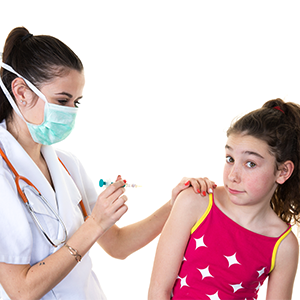As the dog days of summer wind down, many parents begin the necessary prep
work to return their kids to school. Soon-to-be kindergarteners are fitted
with backpacks larger than they are. Nervous incoming middle schoolers
start getting pep talks from equally anxious parents. New high school
freshmen have to explain to mom and dad that last year’s clothes are now
completely out of style.
What most of these kids have in common is that they will all need to get
certain immunizations before they can begin going to classes. Parents go
through their checklists: school supplies, new clothes, cases of their
kids’ favorite snacks and … what else … oh yeah, they finally open that
large manila envelope that has been lying around untouched since June. The
letter inside states that certain forms must be filled out and that
required vaccines must be given. Then panic sets in – 10 days until school
starts, and the next available check-up slot with the pediatrician is not
for two months! After pleading with the pediatrician, the receptionist says
she did some creative scheduling and can squeeze your child in tomorrow.
Thank your lucky stars!
Now comes the hard part – getting your child to the office. She asks you,
“Will I be getting any shots?” (Those may not be her exact words.) You
think about it and say something vague, like, “I’m not sure. We’ll see when
we get there.”
There are three main groups who will be getting their vaccinations:
four-year-olds (usually the year before they start kindergarten), starting
sixth graders and 16/17-year-olds. The kindergarteners will get the
required booster shots (DPT-Diphtheria/Pertussis/Tetanus, Polio and
MMR-V-Measles, Mumps, Rubella, and Chicken Pox). They will also be expected
to have completed the entire series of Polio/DPT/MMR/Chicken Pox and
Hepatitis B. Rising sixth graders need to get the Tdap (a new form of the
tetanus shot) in order to be allowed into school. My office also strongly
recommends that they get the Meningitis and HPV vaccines as well. The
meningitis vaccine covers four of the five deadly strains. They get one at
11 years and a booster at 16/17 years. The HPV (Human Papillomavirus
Vaccine) protects against a set of viruses that can cause cervical, penile,
anal and oral cancer. If given at or before 14 years of age, it is a
two-shot series; if given after 14 years of age, it is a three-shot series.
The 16/17-year-olds will get their second meningitis vaccine and the
Meningitis type B vaccine (also a two-part vaccine). College students who
will be studying or working in hospital or clinical settings may also need
to show proof of TB screening. Most colleges will require that your student
have completed both of the meningitis vaccine series.
For a complete vaccine schedule and copies of the vaccine information
forms, visit:
www.cdc.gov/vaccines/schedules/easy-to-read/index.html.
Depending on where you live (DC, MD, VA), the HPV may be required for
school entry. The typical side effects include muscle aches, injection site
redness and mild fever. Rarely, more serious side effects may occur, such
as allergic reactions or infections. Many websites have attributed other
conditions like primary ovarian insufficiency, Guillain-Barre syndrome and
Postural Orthostatic Tachycardia Syndrome (POTS) to the
administration of HPV. However, the Centers for Disease Control and the
Food & Drug Administration have extensively researched the data and
have not found any relationship between these conditions and the HPV
vaccine.
It’s important for your child’s vaccines to be up-to-date to not only to
protect the child from deadly diseases, but also to prevent spreading those
same diseases to others. These diseases have caused millions of childhood
deaths in the past, and I doubt anyone wants them to return.
So enjoy those last days of summer, but remember to schedule your child’s
check-up and shots before school starts. Many schools will not allow the
student to attend if their physical forms and vaccines are not completed
properly. I encourage everyone to have a good talk with your pediatrician
about the vaccines necessary for school. As they say, an ounce of
prevention is worth a pound of cure.


